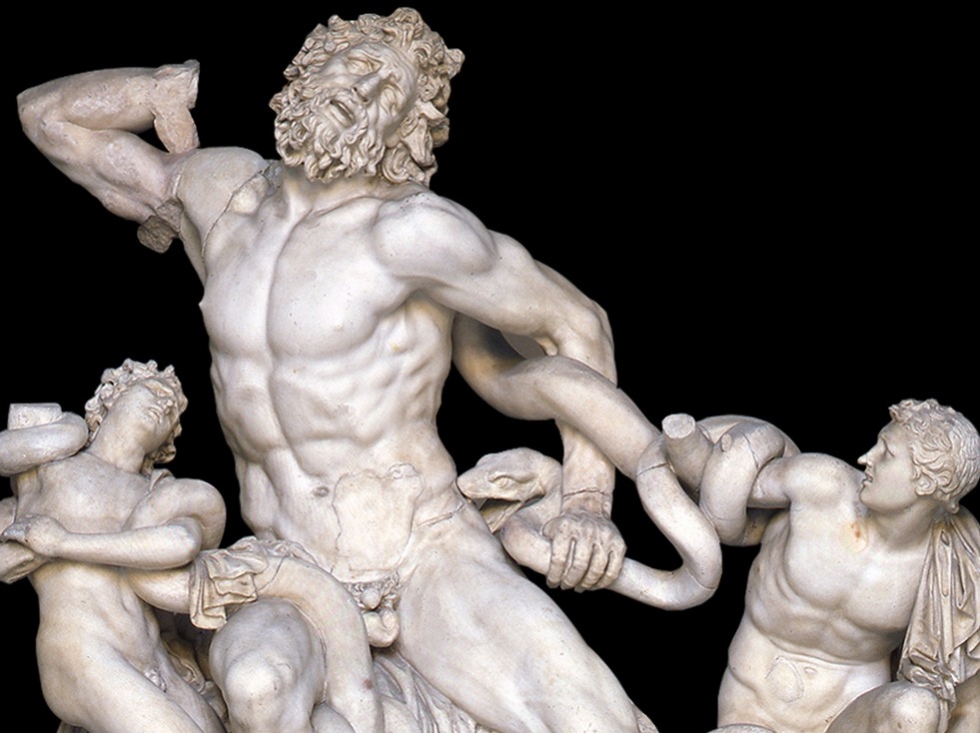The Laocoon group, known simply as the Laocoon, is one of the most famous sculptures in the world. Masterpiece of Ancient Roman art, probably carved in the second half of the 1st century BC, it is a marble copy of a Hellenistic bronze statue, likely produced by the school of Pergamon. Attributed to Agesander, Polydorus and Athenodorus, three very famous sculptors from Rhodes, it represents one of the most famous episodes from the Iliad, described in detail by Vergil in the Aeneid.
Laocoon, priest of Apollo, attempts to discourage the Trojans from letting the wooden horse, left of the shore by Achaeans, into the Trojan walls. Athena, that protects the Greeks, in order to punish the priest and convince his fellow citizens, sends two sea monsters (two giant snakes) attacking the man and his two children and killing them all. Terrified by what just happened and believing that the event is clearly a divine punishment for Laocoon, the Trojans bring the horse into the city, causing in this way the destruction of their beloved homeland. It is possible to admire this extraordinary work at the Vatican Museums, in the octagonal courtyard of these incredibly famous museums. The courtyard was designed by Donato Bramante appositely for this statue, that was positioned here after its discovery. Except for a brief period in which it was brought to the Louvre by Napoleon (from 1798 to 1815), the statue has always been in the Vatican Museums. The story of its discovery is particularly interesting. It was found the 14th January 1506 in the great excavations in the area of the Oppian Hill, over the Domus Aurea. Michelangelo and Giuliano da Sangallo (Lorenzo the Magnificent’s favorite architect) assisted to these excavations too, and it’s the latter that immediately identified the statue emerging from the ground. The Florentine architect, in fact, read a work from the Ancient Roman writer and naturalist Pliny the Elder, in which the author meticulously describes this sculpture, admired in the residence of the future emperor Titus, that, indeed, had his luxurious dwelling on the Oppian Hill. What strikes the most about this marble sculptural group is the expressive power of the Trojan priest. His furious writhing that almost makes him loose his balance, his desperate twisting and soaring upwards (it is almost 2,50 meters tall) in the extreme attempt to release himself from the mortal grip, the tensing and relaxing of his muscles that indicate the effort of using all of his strength, confer a remarkable dramatic expressivity to the statue, that perfectly translate in stone the physical and psychological pain of a man close to his end. Laocoon’s face expresses the struggle of someone trying in vain to escape from death and the despair of someone that cannot help avoiding the same fate to his children. Dramatic and moving, the Laocoon draws the attention of numerous tourists visiting the Vatican Museums every day, representing, for sure, one of the most admired and photographed statues in Rome. Masterpiece of Roman art, it immediately reached popularity after its discovery. It influenced not only Italian Renaissance art, but also Baroque art, and its reputation quickly spread throughout Europe. The French monarchy even attempted to take possession of it, during the papacy of Clemens VII, but failed, and the king had to make do with a simple mold, from which he obtained a bronze copy. After all the torment and desperate torsion of Laocoon moved and inspired artists such as Michelangelo, Titian and later Bernini. Many intellectuals actually have dedicated studies to this incredible work through the centuries. Just one example of this would be Goethe, the German writer, that in his work “The Laocoon” took this sculpture as model and universal symbol of artistic perfection.
Giuseppe Rosselli




